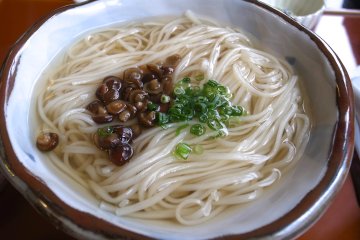Akita is a great place to sightsee and is known for its local dishes and cuisine that are bound to make your experience even more memorable. The prefecture’s location near the sea guarantees great seafood, and it’s well-known for its rice and chicken. When you’re not checking out Akita’s hot springs, ancient history and many monuments around the city, enjoy its legendary cuisine.
Kiritanpo

Kiritanpo is made with cooked rice that is pounded into skewers, grilled, and then served in a hotpot with miso paste. The hotpot includes a broth with chicken, mushrooms, green onions and other vegetables. This dish is from the Odate region of Akita, where the people of the land made this meal using leftover rice. Known for being a warm meal during the prefecture’s colder season, it’s a favorite among Akita’s locals.
Inaniwa udon

Inaniwa udon is a local variant of the udon noodle that is thinner and chewier than usual. It’s considered to be one of the three most famous types of udon in the country. The udon is said to have originated in the area over 300 years ago and has since been served to the Ministry of the Imperial Household, as well as won many regional food cuisine awards. The noodle even has a feature in “Oishinbo,” a gourmet food manga. Akita locals would also hold familial gatherings and serve this udon dish, leading to the dish’s endearing nickname, udonko.
Iburi Gakko (pickled vegetables)

Iburi gakko are fresh vegetables that are washed and then pickled using a traditional Akita method. This process includes hanging the vegetables in a shed and then smoking them with apple, chestnut or cherry wood, giving them a smoky taste and aroma. The vegetables are then pickled in a mixture of rice bran, sugar and salt for a few months. Japanese pickles have always been unique and have a long history since Edo times. In the Akita dialect, the word for pickles is Gakko. These pickles are generally served with rice or soup, and are often paired with cream cheese.
Kamabuku

This versatile fishcake has existed in Japanese cuisine since ancient times and is typically made with fish. In Akita prefecture, it’s called "Kamabuku" and is made with potatoes, mochi flour, sugar and salt. Since Akita is a very snowy area, there was a time when agriculture was difficult in the northern parts due to harsh weather. Locals of this area had to adapt and use unique ways of cooking to cope and therefore came up with this alternative recipe for this Japanese fishcake. Occasionally people will add colorful ingredients like pumpkin to decorate the dish, and this sweet is considered to represent the wisdom of Akita’s ancestors.
Hatahata zushi

Hatahata zushi has been a part of Akita’s cuisine for centuries. The dish is made with sandfish that can be found in the Sea of Japan during winter. The fish is salted and then marinated in a rice and koji malt, a fungus used to ferment food and make sake. The fish is named after the word for thunderbolt, “Hatahatagami”, considering the season to catch it is known to have harsh climate conditions and thunderstorms. The Akita locals have a folk song about this famous fish, where they sing “you can’t welcome the New Year with hatahata”. They pickle sushi with the hatahata and serve it on New Years. This dish is considered incredibly high-quality due to the nature of its preparation and is an important part of Akita’s cultural cuisine.











